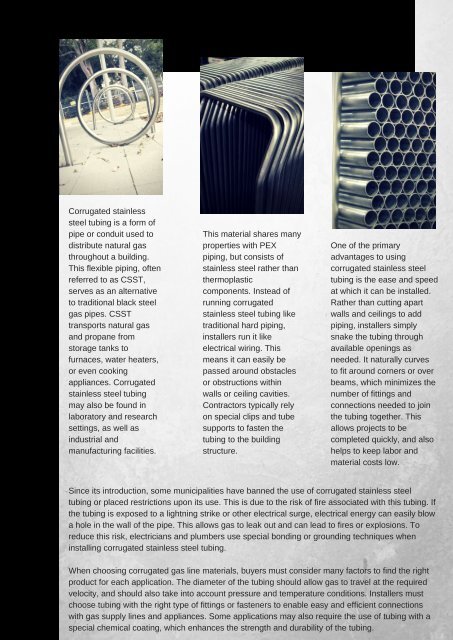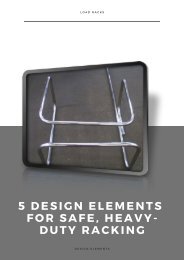What is Corrugated Stainless Steel Tubing
Corrugated Stainless Steel Tubing (CSST) is a flexible, stainless steel pipe used to supply natural gas and propane in residential, commercial and industrial structures.
Corrugated Stainless Steel Tubing (CSST) is a flexible, stainless steel pipe used to supply natural gas and propane in residential, commercial and industrial structures.
Create successful ePaper yourself
Turn your PDF publications into a flip-book with our unique Google optimized e-Paper software.
<strong>Corrugated</strong> stainless<br />
steel tubing <strong>is</strong> a form of<br />
pipe or conduit used to<br />
d<strong>is</strong>tribute natural gas<br />
throughout a building.<br />
Th<strong>is</strong> flexible piping, often<br />
referred to as CSST,<br />
serves as an alternative<br />
to traditional black steel<br />
gas pipes. CSST<br />
transports natural gas<br />
and propane from<br />
storage tanks to<br />
furnaces, water heaters,<br />
or even cooking<br />
appliances. <strong>Corrugated</strong><br />
stainless steel tubing<br />
may also be found in<br />
laboratory and research<br />
settings, as well as<br />
industrial and<br />
manufacturing facilities.<br />
Th<strong>is</strong> material shares many<br />
properties with PEX<br />
piping, but cons<strong>is</strong>ts of<br />
stainless steel rather than<br />
thermoplastic<br />
components. Instead of<br />
running corrugated<br />
stainless steel tubing like<br />
traditional hard piping,<br />
installers run it like<br />
electrical wiring. Th<strong>is</strong><br />
means it can easily be<br />
passed around obstacles<br />
or obstructions within<br />
walls or ceiling cavities.<br />
Contractors typically rely<br />
on special clips and tube<br />
supports to fasten the<br />
tubing to the building<br />
structure.<br />
One of the primary<br />
advantages to using<br />
corrugated stainless steel<br />
tubing <strong>is</strong> the ease and speed<br />
at which it can be installed.<br />
Rather than cutting apart<br />
walls and ceilings to add<br />
piping, installers simply<br />
snake the tubing through<br />
available openings as<br />
needed. It naturally curves<br />
to fit around corners or over<br />
beams, which minimizes the<br />
number of fittings and<br />
connections needed to join<br />
the tubing together. Th<strong>is</strong><br />
allows projects to be<br />
completed quickly, and also<br />
helps to keep labor and<br />
material costs low.<br />
Since its introduction, some municipalities have banned the use of corrugated stainless steel<br />
tubing or placed restrictions upon its use. Th<strong>is</strong> <strong>is</strong> due to the r<strong>is</strong>k of fire associated with th<strong>is</strong> tubing. If<br />
the tubing <strong>is</strong> exposed to a lightning strike or other electrical surge, electrical energy can easily blow<br />
a hole in the wall of the pipe. Th<strong>is</strong> allows gas to leak out and can lead to fires or explosions. To<br />
reduce th<strong>is</strong> r<strong>is</strong>k, electricians and plumbers use special bonding or grounding techniques when<br />
installing corrugated stainless steel tubing.<br />
When choosing corrugated gas line materials, buyers must consider many factors to find the right<br />
product for each application. The diameter of the tubing should allow gas to travel at the required<br />
velocity, and should also take into account pressure and temperature conditions. Installers must<br />
choose tubing with the right type of fittings or fasteners to enable easy and efficient connections<br />
with gas supply lines and appliances. Some applications may also require the use of tubing with a<br />
special chemical coating, which enhances the strength and durability of the tubing.




